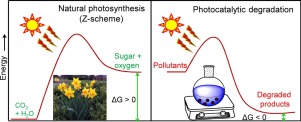Applied Catalysis B: Environment and Energy ( IF 20.2 ) Pub Date : 2018-01-08 , DOI: 10.1016/j.apcatb.2018.01.015 Thillai Sivakumar Natarajan , K. Ravindranathan Thampi , Rajesh J. Tayade

|
Semiconductor photocatalysis using single or modified semiconductors and heterojunction-type composites is limited due to lower visible light response, rapid recombination of photogenerated charge carriers and low redox potentials of photoactive materials. Recently the coordinated applications of two or more semiconductors are becoming popular, an idea borrowed from the thermodynamically uphill driven tandem Z-scheme concept used for photoelectrochemical splitting of water involving two different semiconductors with improved overall visible light response. Consequently, in thermodynamically downhill photocatalytic reactions for pollutant degradation involving dual semiconductors as well the word “Z-scheme” is being used to explain the observed efficient electron-hole separation mechanism. Whereas the Z-scheme classically represents only thermodynamically uphill photosynthetic reactions (ΔG > 0), the photocatalytic degradation of pollutants, on the other hand, are thermodynamically downhill reactions (ΔG < 0), and this usage is creating a misconception and ambiguity in the field of photocatalysis. Therefore, herein we discuss the principles of the often called ‘Z-scheme photosystems’ involving (i) shuttle redox-mediators, (ii) dual semiconductors photocatalysts with solid state electron mediators and (iii) redox-mediator-free direct systems. The review relevantly summarizes and discusses various representative dual semiconductor photocatalytic systems with solid state mediators as well as non-mediated direct dual semiconductor photocatalysts studied for the degradation of pollutants under visible light irradiation. The future requirements for the development of an efficient visible light driven redox-mediator-free and durable direct dual semiconductor photocatalytic system for the degradation of pollutants is also presented.
中文翻译:

可见光驱动的无氧化还原介质的双半导体光催化系统,用于污染物降解以及应用Z方案概念的歧义
由于较低的可见光响应,光生电荷载流子的快速重组以及光敏材料的氧化还原电势低,使用单一或改性半导体和异质结型复合材料的半导体光催化受到限制。最近,两个或多个半导体的协调应用变得很流行,这个想法是从热力学上驱动的串联Z方案概念中借鉴来的,该概念用于水的光电化学分解,涉及两个具有改善的整体可见光响应的不同半导体。因此,在热力学下坡道的光催化降解污染物的催化反应中,涉及双半导体以及“ Z方案”一词被用来解释观察到的有效的电子-空穴分离机理。Z方案通常仅代表热力学上坡的光合作用反应(ΔG> 0),而污染物的光催化降解则是热力学上坡的光合作用反应(ΔG<0),这种用法造成了误解和歧义。光催化领域。因此,本文中我们讨论了通常被称为“ Z方案光系统”的原理,该原理涉及(i)穿梭氧化还原介体,(ii)具有固态电子介体的双半导体光催化剂和(iii)无氧化还原介体的直接系统。审查与此相关地总结和讨论了各种具有固态介体的非典型双半导体光催化体系,以及研究了在可见光照射下污染物降解的非介导直接双半导体光催化剂。











































 京公网安备 11010802027423号
京公网安备 11010802027423号